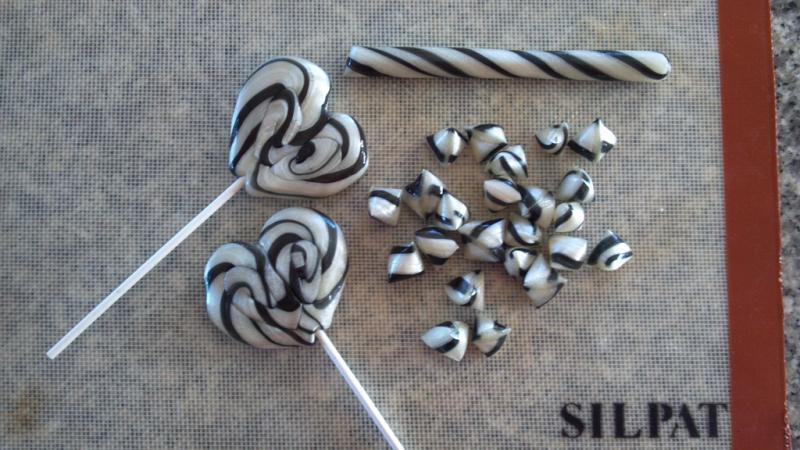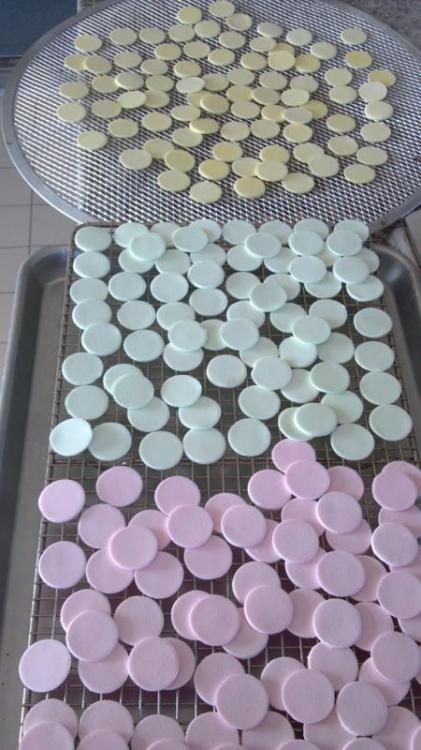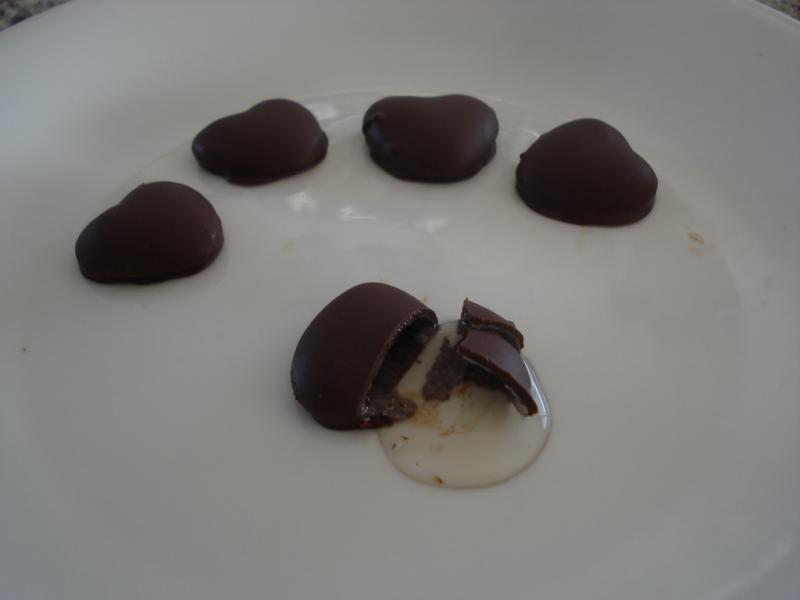
minas6907
participating member-
Posts
900 -
Joined
-
Last visited
Content Type
Profiles
Forums
Store
Help Articles
Everything posted by minas6907
-
You should try it! Once you get the hang of it you can make some cool stuff, and it'll toughen up your hands! Currently, the thrill of working with sugar has sort of worn off (I was thinking of getting into cheese) so when I do things now, its just for special occasions and way to sort of personalize a gift.
-
I make a cheesecake every now and then from The Professional Pastry Chef. The recipe states that it will make 2 25cm cakes, or 4 17.5cm cakes. The only difference is the baking times, the smaller ones obviously bake a little quicker. I've made both sizes with the same result, just keep your eye on them.
-
Thank you. I just used a small metal round cutter, the kind you get in a set from ateco with a very thin edge.
-
Heres a few things I just got done with. I made some pastillage yesterday for some wafer candies for my friends wedding, the pink is raspberry, green is pear, and yellow is lemon. Also, for the same friend, to accompany their gift, I made some heart shaped lollipops, and while I was at it made a licorice stick and some drops for the roommate.
-
That's something to consider, thanks. Out of curiosity though, how long would it have taken to make the second layer? How large of batches were you guys doing? Sent from my DROID X2 using Tapatalk 2
-
Hi Everyone. I have a simple question regarding pdf's. A friend of mine asked me to make some for his wedding coming up next Saturday, so I was thinking of doing a layered pdf, perhaps something like raspberry and apricot. If I make a 1/4 inch layer of one fruit jelly, is there anything special I need to do make the other layer adhere to the first? I've only done these one time, and want to be extra sure before I start. I was planning on making a raspberry pdf, letting it set up, then pour the apricot pdf on top of it, just wanted to make sure there isn't anything I'm not taking into consideration. Thanks :-) Sent from my DROID X2 using Tapatalk 2
-
Ooooo yummy! I've wanted to try those, they look so easy to make! As far as labeling is concerned, coconut fat is the same as coconut oil, right? Sent from my DROID X2 using Tapatalk 2
-
Looks nice, I like the idea of using goat cheese. What's the shelf life like on could something like that? I guess it would have to be better then I'm thinking, because just mixing chocolate with cream makes something that's stable. Nice picture. Sent from my DROID X2 using Tapatalk 2
-
Ah, that last part probably did it, I think you'll hit it spot on the next time. Sent from my DROID X2 using Tapatalk 2
-
Hey Kerry, what temperature did you cook the syrup to? Whats the proof on the bottle of Fragioli? After reading all about these, I got the impression that theirs a little bit of guess work involved when using low proof or sweet liquors, which is why, even though I wanted to do a Grande Marnier cordial, I just chose a standard 80 proof alcohol for my first run though...then after seeing the work involved I haven't gone back to them haha, even though I'd like to. I have a feeling if you cook the syrup to 119c and just use a vodka/tequila/whiskey/etc, your get good results. And I suppose if they crack when you do turn them, just give them more time, even though he says 4 to 5 hours. Turn the pieces is listed as optional in Grewelings book, and I dont believe I remember seeing that in the instructions in Notters book, and mine came out nicely. Heres a pic of the ones I did a while back. Theres only five because I chose the best looking ones, the others looked awful from my dipping, and as I recall, I think like four or so broke while dipping, so I had to rescue the chocolate a few times, surprised I was able to. I'm looking forward to seeing how your turn out.
-
I was saying cordials because that's what they are labeled as in his book, page 253.
-
For the liquid center I just use a funnel and a small pitcher/measuring cup. Its pretty easy to control the pour. Also, Kerry, did you turn every center, or leave some alone? I havent done Greweling formula for the cordials, but Notters from The Art of the Chocolatier worked nicely, no turning.
-
Because I'm an idiot. I did similar math when I started in Chocolates and Confections and wanted to make a half recipe for something that got poured into a 12 inch frame, and I realized by doing the same math that I would need a 8.5 inch frame for a half recipe, and being the genius I am I thought I could apply it here, but it obviously doesn't work, that's why I'm not the pastry chef. Sent from my DROID X2 using Tapatalk 2
-
That sounds more accurate, I just wish I was a mathematician.
-
Thanks lebowits. Now that I think of it, Professional Baking ( http://www.amazon.com/Professional-Baking-Wayne-Gisslen/dp/047178348X/ref=sr_1_1?ie=UTF8&qid=1341658629&sr=8-1&keywords=professional+baking ) has large scale formulas for all the recipes in the book. Also, perhaps pick up a copy of The Professional Pastry Chef, On Baking, or CIA's Baking and Pastry. If your doing large scale stuff, I'd probably dump the recipes you have that are for the home and pick up a text that focuses on cooking for large amounts. Food for Fifty isnt bad also, but I would do the previously mentioned books before this one.
-
Well for the scaling, this is what I would do: 9x9=81 18x26=468 square root of 81=9 square root of 468=21.63 21.63/9=2.40 So for a recipe that is made to fit into a 9x9 pan, it needs to be scaled 2.40 times, or just 2.5 for simplicity's sake. I'm not pastry chef, nor am I good with math, so if anyone knows an easier way I'd like to know.
-
Molded and Filled Chocolates: Troubleshooting and Techniques
minas6907 replied to a topic in Pastry & Baking
Yikes, what happened there? DId the top of the bonbon stick to the mold and the bottom break off? What a nightmare cleaning those molds! -
What was the ingredients in the center? You got a picture of a chocolate cut open? That's pretty much how every batch of tempered chocolate turns out for me, I've gotton better, but still seem to have some streaks. Yours do look nice though. On a separate note, why does fondant need to ripen for 24 hrs after its made? After you make it, why can't you melt it down and cast it? Is it crystallizing in that time it sits? Will it just not really set up if you tried to make candies with it immediately? Sent from my DROID X2 using Tapatalk 2
-
"The Art of the Confectioner: Sugarwork and Pastillage"
minas6907 replied to a topic in Cookbooks & References
I think I know what you mean Cat, the exitement for me wore off a bit, though it lasted for month or so. It is a beautiful book, and I do know what you mean with the white backdrops, but it was probably the best bet for them seeing as how he models a number of different pieces all with different colors, but even so, I still thought the pastillage pieces looked nice with the white on white, but overall it was probably best to use the same plain backround for every single piece. The directions can sort of be difficult to follow also, but thats sort of what I would expect. Expect for pastillage, which is pretty much 'cut and dry,' the sugar work really is something a person has to get a feel for, so without having any formal training and being taught by someone else, the instructions in the book are pretty much as good as you can get. I was also pleased to finally see a book that is recently published on sugar work, there are not too many of them. Of the ones I've searched for, they are pretty much all out of print, and if you want a copy, your going to shell out some serious cash for a new or used copy. I also have pastry books like "The Professional Pastry Chef" and "Professional Baking" which do cover pulled sugar, but it can only be said that they skim the surface compared Notters book. After spending so much time looking on youtube video of pulled, blown, and cast sugar, I was semi blown away when I saw some on the things Notter does in his sugar book, even how beautiful you can make a cast piece, or blow a transparent piece of sugar, his work truly is impressive. Anyways, The book is aimed, obviously, at ones who would be competing in competitions, with a hefty part dedicated to the templates, but much of it can be done at home. If someone is doing this kind of work, they already know how to mold or pull hard candy. I could probably say that was a small disappointment for me, in Notters chocolate book, he has formulas for candy in addition to showpiece work, so I was sort of expecting the same on some level with the name Confectioner in the title, but nope, just showpieces :-). Thanks for your response Cat, for a while I thought I was the only person here that got exited about this book! -
That's a beautiful work area Sent from my DROID X2 using Tapatalk 2
-
Candying fruit isnt really an area I'm into, but I think Chocolates and Confections is about as detailed a guide as you can get.
-
By the way, the reason I asked how many will be there is because it might be worth it to just do it by hand if its not a large crowd, unless you really want to have a cotton candy machine. The method for making spun sugar in Notters "Art of the Confectioner" is considerably less messy then the usual way of flinging sugar between two dowels. Also, if you do get the machine, make sure you use some new candy that hasn't started to crystallize. In some of the reviews for the machine, a few people said it didnt work at all with their hard candy, but I suspect that the outside of the candy they had started to crystallize, and then of course it wouldnt be able to melt and spun properly.
-
How many kids will be at the party?
-
Huh. Neat, thanks for the photo, thats interesting seeing what a contrast the different pectins would produce.
-
I have a feeling that when the candy maker said they dont make them as sweet as they used too, they probably made them using a considerable amount of honey. I'd find it very hard to think that the candy makers on the streets on Hong Kong are using isomalt to make this stuff, its just a simple candy boiled to be a bit stiffer them taffy. We dont know what additional ingredients they added to the candy when annachan was a child.



